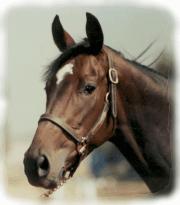A Horse, of Course with Don Blazer |
If you enjoy learning about horses, then you'll love our online courses. Each month you'll find a new column on our web site. We hope you'll enjoy it, and maybe e-mail us with questions or suggestions for other columns. A Horse, Of Course is a monthly column syndicated by Success Is Easy. If you like the column, call your local newspaper, or local horse publication and ask them to subscribe by contacting Success Is Easy. |
Slowing and softening your horse's gaits begin with the mind and are reinforced with lateral movement. The first step is to slow yourself down. You must start thinking "slow" instead of thinking about getting things done now. So much of daily life today is multi-tasking, instant results and moving forward. It may work for you, but it doesn't for your horse. Don't get in a hurry. Move slowly when working around your horse, and ask him to move slowly when you lead him. Make it a habit to slow everything down. When you get to your training area….arena or pen or open field….never allow your horse to begin his work with speed, that promotes fast work and gets "speed" into your horse's mind. Walk your horse and walk slowly. Make "slow" the first lesson of all training. If you are going to lunge, begin by making the horse walk, and walk slowly. Don't encourage speed hoping to tire the horse so he'll go slowly…it won't work. He may be tired, but he'll still be thinking speed; what's worse is when tired, he won't enjoy his lesson, so what he learns is "speed" and a dislike for what comes after it. If you are riding into an arena or work area, do lots of slow walking. Don't canter or gallop trying to take the "edge off." Fast work to take the edge off teaches horse that his first reaction to a work area should be "speed." You may take the edge off, but your lesson has taught the wrong thing. When you are thinking "slow" and your horse is thinking "slow" you can begin to teach lateral work to soften your horse's gaits. A horse cannot flex his leg laterally from the elbow down since the joints are hinge joints and limited to flexion and extension only, so make your first lateral lesson the easiest, the two-track. A horse two-tracks by moving his hip over to put his body into a 45 degree angle to his direction of travel. By moving the hip over, he establishes two tracks…a set of tracks for his forefeet and a set of tracks for his hind feet. (View the video at: http://www.donblazer.com/videos/two_tracking.html to see a demonstration of two-tracking.) The cues for two-tracking combine a blocking action with the rein and a pushing action with the leg. For example, if you are moving to the right, your left leg will drop back slightly to push the horse's hip to the left while your right rein is pushed into the horse's neck to block the forehand from moving to the right. Do not pull the horse's head to the left. The correct action is to move the horse's hip to the right. Do not expect the horse to learn two-tracking in one session. You want to think "slow" and allow the horse to learn "slowly." Ask the horse to move his hip over, and praise him anytime and every time he makes even the slightest effort to respond. Lateral work is the most difficult for the horse to learn, so don't get in a rush. Start teaching the two-track while walking; then move to the jog or trot, and finally to the lope or canter. By moving the horse's hip, you will both slow and soften his gait. Moving the hip helps the horse to get his hind feet under his body, which allows him to round up his back and carry his weight in a balanced position. You'll find that once you master the two track, your horse will become much lighter and softer when you ask for the lope. Without you even thinking about it, your horse will move his hip slightly into the direction of travel when you ask for the lope or canter. When he moves his hip into the direction of travel, he'll be able to also tip his nose into the direction of travel, which will give you the perfect arc for a slow, soft gait. By mastering the two-track you'll avoid turning the horse's head away from the lead you are requesting, and you won't be turning your horse's head into the rail, a major fault of so many pleasure horses. Change your mind set and change your horse's movement to a lateral one and you'll have mastered the first steps to slow and soft gaits. Visit A Horse, Of Course on the Internet at www.donblazer.com |
